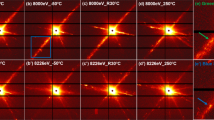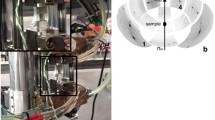Abstract
Shape memory alloys (SMAs) show great potential across many fields and various applications with their unique shape memory abilities. These abilities stem from a solid-state martensite transformation, where this martensite phase acts as a long-range ordering of lattice strain. Strain glass alloys (SGAs) originate from SMAs in which the long-range martensitic transformation is replaced with a strain glass transition. These SGAs originate from inducing a sufficient amount of lattice distortion into a SMA system to frustrate the quintessential martensitic transformation enough to generate a strain glass transition. This results in a structure of a distorted crystalline matrix with nano domains of glassy martensite. In this study, we compare the transformation behavior of a martensitic NiTi SMA with a processing-induced NiTi SGA during thermal cycling using wide-angle synchrotron radiation X-ray diffraction (WAXS). Based on the thermal cycling results, three observations about processing-induced SGAs as compared to SMAs can be seen: (1) retention of distorted austenite at high and low temperatures, (2) broadening of diffraction peaks in WAXS and disappearance of the thermal peaks in DSC measurements both due to induced strain, and (3) gradual increase in the amount of the martensitic phase.





Similar content being viewed by others
References
Mohd Jani J, Leary M, Subic A, Gibson MA (2014) A review of shape memory alloy research, applications and opportunities. Mater Design (1980-2015) 56:1078–1113. https://doi.org/10.1016/j.matdes.2013.11.084
Wheeler RW et al (2019) Engineering design tools for shape memory alloy actuators: CASMART collaborative best practices and case studies. J Intell Mater Syst Struct 30(18–19):2808–2830. https://doi.org/10.1177/1045389X19873390
Barbarino S, Saavedra Flores EI, Ajaj RM, Dayyani I, Friswell MI (2014) A review on shape memory alloys with applications to morphing aircraft. Smart Mater Struct 23(6):063001. https://doi.org/10.1088/0964-1726/23/6/063001
Caltagirone PE et al (2021) Shape memory alloy-enabled expandable space habitat—case studies for second CASMART student design challenge. Shap Mem Superelasticity 7(2):280–303. https://doi.org/10.1007/s40830-021-00329-y
Costanza G, Tata ME (2020) Shape memory alloys for aerospace, recent developments, and new applications: a short review. Materials. https://doi.org/10.3390/MA13081856
Benafan O et al (2014) Shape memory alloy actuator design: CASMART collaborative best practices and case studies. Int J Mech Mater Des 10(1):1–42. https://doi.org/10.1007/s10999-013-9227-9
Hartl DJ, Lagoudas DC (2007) Aerospace applications of shape memory alloys. Proceed Inst Mech Eng Part G 221(4):535–552. https://doi.org/10.1243/09544100JAERO211
Antonucci V, Martone A (2015) Phenomenology of shape memory alloys. Shape memory alloy engineering. Elsevier, Amsterdam, pp 33–56. https://doi.org/10.1016/B978-0-08-099920-3.00002-4
Kumar PK, Lagoudas DC (2008) “Introduction to shape memory alloys. Shape memory alloys. Springer, Boston. https://doi.org/10.1007/978-0-387-47685-8_1
Otsuka K, Ren X (2005) Physical metallurgy of Ti–Ni-based shape memory alloys. Progress Mater Sci 50(5):511–678. https://doi.org/10.1016/j.pmatsci.2004.10.001
Wang Y, Ren X, Otsuka K (2006) Shape memory effect and superelasticity in a strain glass alloy. Phys Rev Lett. https://doi.org/10.1103/PhysRevLett.97.225703
Sarkar S, Ren X, Otsuka K (2005) Evidence for strain glass in the ferroelastic-martensitic system Ti50-xNi50+x. Phys Rev Lett. https://doi.org/10.1103/PhysRevLett.95.205702
Ren X (2014) Strain glass and ferroic glass—unusual properties from glassy nano-domains. Physica Status Solidi (B)Basic Res 251(10):1982–1992. https://doi.org/10.1002/pssb.201451351
Ren X (2012) Strain glass and strain glass transition. Disorder and strain-induced complexity in functional materials, vol 148, 1st edn. Springer, Berlin. https://doi.org/10.1007/978-3-642-20943-7_11
Wang D et al (2010) Strain glass in Fe-doped Ti–Ni. Acta Mater 58(18):6206–6215. https://doi.org/10.1016/j.actamat.2010.07.040
Cui J, Ren X (2014) Elinvar effect in Co-doped TiNi strain glass alloys. Appl Phys Lett. https://doi.org/10.1063/14893003
Zhou Y, Xue D, Ding X, Otsuka K, Sun J, Ren X (2009) High temperature strain glass in Ti50 (Pd50-x Crx) alloy and the associated shape memory effect and superelasticity. Appl Phys Lett. https://doi.org/10.1063/13249580
Frenzel J, Wieczorek A, Opahle I, Maaß B, Drautz R, Eggeler G (2015) On the effect of alloy composition on martensite start temperatures and latent heats in Ni–Ti-based shape memory alloys. Acta Mater 90:213–231. https://doi.org/10.1016/j.actamat.2015.02.029
Zhang Z, Wang Y, Wang D, Zhou Y, Otsuka K, Ren X (2010) Phase diagram of Ti50−x Ni50+x: crossover from martensite to strain glass. Phys Rev B 81(22):224102. https://doi.org/10.1103/PhysRevB.81.224102
Wheeler RW, Smith J, Ley NA, Giri A, Young ML (2019) Shape memory behavior of Ni49.5Ti50.5 processing-induced strain glass alloys. Minerals, metals and materials series. Springer, Cham, pp 1411–1420. https://doi.org/10.1007/978-3-030-05861-6_134
Wheeler RW, Smith J, Ley NA, Giri A, Young ML (2018) Processing-induced strain glass states in a Ni49.5Ti50.5 shape memory alloy. Appl Phys Lett. https://doi.org/10.1063/15049871
M. H. Wu and L. McD. Schetky, 2000 “Industrial Applications for Shape Memory Alloys,” in International Conference on Shape Memory and Superelastic Technolgies. California. 171–182. https://mrkspecialitymaterials.com/pdf/Tech%20Paper%20-%20Nitinol_Industrial_Applications.pdf
Koike J, Parkin DM, Nastasi M (1990) Crystal-to-amorphous transformation of NiTi induced by cold rolling. J Mater Res 5(7):1414–1418. https://doi.org/10.1557/JMR.1990.1414
Sergueeva AV, Song C, Valiev RZ, Mukherjee AK (2003) Structure and properties of amorphous and nanocrystalline NiTi prepared by severe plastic deformation and annealing. Mater Sci Eng A 339(1–2):159–165. https://doi.org/10.1016/S0921-5093(02)00122-3
Yan B, Jiang S, Sun D, Yu J, Zhang Y (2021) Comparison for grain growth dynamics of severely deformed austenite and martensite NiTi shape memory alloys after complete crystallization of amorphous phase. J Mater Eng Perform 30(8):6191–6202. https://doi.org/10.1007/s11665-021-05818-w
Birk T, Biswas S, Frenzel J, Eggeler G (2016) Twinning-induced elasticity in NiTi shape memory alloys. Shap Mem Superelasticity 2(2):145–159. https://doi.org/10.1007/s40830-016-0064-1
Tsuchiya K et al (2006) Martensitic transformation in nanostructured TiNi shape memory alloy formed via severe plastic deformation. Mater Sci Eng A 438–440:643–648. https://doi.org/10.1016/j.msea.2006.01.110
Liang Q et al (2017) Novel B19′ strain glass with large recoverable strain. Phys Rev Mater 1(3):033608. https://doi.org/10.1103/PhysRevMaterials.1.033608
Kakeshita T, Fukuda T, Saxena A, Planes A (2011) Disorder and strain-induced complexity in functional materials. Springer Series Mater Sci. https://doi.org/10.1007/978-3-642-20943-7
Kudoh Y, Tokonami M, Miyazaki S, Otsuka K (1985) Crystal structure of the martensite in Ti-49.2 at %Ni alloy analyzed by the single crystal X-ray diffraction method. Acta Metallurgica. https://doi.org/10.1016/0001-6160(85)90128-2
Dwight A (1959) CsCl-type equiatomic phases in binary alloys of transition elements. Trans Am Inst. Min Metall Eng 215:283
Young ML, Almer JD, Daymond MR, Haeffner DR, Dunand DC (2007) Load partitioning between ferrite and cementite during elasto-plastic deformation of an ultrahigh-carbon steel. Acta Mater 55(6):1999–2011. https://doi.org/10.1016/j.actamat.2006.11.004
Young ML, Wagner MF-X, Frenzel J, Schmahl WW, Eggeler G (2010) Phase volume fractions and strain measurements in an ultrafine-grained NiTi shape-memory alloy during tensile loading. Acta Mater 58(7):2344–2354. https://doi.org/10.1016/j.actamat.2009.12.021
Carl M, van Doren B, Young ML (2018) In situ synchrotron radiation X-ray diffraction study on phase and oxide growth during a high temperature cycle of a NiTi-20 at.% Zr high temperature shape memory alloy. Shap Mem Superelasticity 4(1):174–185. https://doi.org/10.1007/s40830-018-0149-0
Acknowledgments
The authors would like to acknowledge Scott Schlegel, Brian Van Doren, and ATI Specialty Alloys and Components for supplying the material. This work was performed in part at the University of North Texas's Materials Research Facility: A shared research facility for multi-dimensional fabrication and characterization. This research used resources of the Advanced Photon Source, a U.S. Department of Energy (DOE) Office of Science User Facility operated for the DOE Office of Science by Argonne National Laboratory under Contract No. DE-AC02-06CH11357. The authors would like to thank Chris Benmore at APS sector 6 for help with collecting diffraction patterns. This work was performed under a cooperative agreement between the DEVCOM Army Research Laboratory and the University of North Texas (W911NF-13-2-0018).
Author information
Authors and Affiliations
Corresponding author
Additional information
Publisher's Note
Springer Nature remains neutral with regard to jurisdictional claims in published maps and institutional affiliations.
This article is an invited submission to Shape Memory and Superelasticity selected from presentations at the Shape Memory and Superelastic Technology Conference and Exposition (SMST2022) held May 16–20, 2022 at The Westin Carlsbad Resort, San Diego, California, and has been expanded from the original presentation. The issue was organized by Dr. Srinidhi Nagaraja, G.RAU, Inc. and Dr. Ashley Bucsek, University of Michigan.
Rights and permissions
Springer Nature or its licensor (e.g. a society or other partner) holds exclusive rights to this article under a publishing agreement with the author(s) or other rightsholder(s); author self-archiving of the accepted manuscript version of this article is solely governed by the terms of such publishing agreement and applicable law.
About this article
Cite this article
Ashmore, B., Young, M.L. & Giri, A. Synchrotron Radiation X-ray Diffraction Measurements of the Thermal Response of a Processing-Induced NiTi Strain Glass Alloy. Shap. Mem. Superelasticity 9, 87–96 (2023). https://doi.org/10.1007/s40830-023-00424-2
Received:
Revised:
Accepted:
Published:
Issue Date:
DOI: https://doi.org/10.1007/s40830-023-00424-2




